#historical accounts
Text
reblog and tag ur answer so I can see please :)
#hello first ever poll how did I do#I know this is kind of a wild spread I wanted to pick things that are maybe less accessible today/have more historic precedence I guess ??#I also only picked foods I was already familiar with / was able to find firsthand historical accounts of#cause I didn’t want to fuck anything up lol#for the record I’m between Roman and tang dynasty#anyways#mike makes polls#mike speaks#I also wanted them to be like a normal/ popular meal that would be eaten by most folk regularly#other than the Abraham Lincoln one lmao
14K notes
·
View notes
Text
biological differences between men and women are inherently neutral. they do not indicate male superiority over female people. to suggest so is inherently sexist. to complain when female sports cater to female anatomy - such as the smaller balls in the wnba because women tend to have smaller hands - is what sexists do. they want women to be forced to prove ourselves according to standards designed for men because they want to see us fail. it is sexist to argue that women who wish to compete on their own terms are pronouncing themselves as inferior. nobody said that but you. because you’re a sexist that hates women
#and beyond physical differences#there are long standing historical social inequities#that produce disparities between men and women that have nothing to do with anatomy#how we build both female and mixed sex spaces has to take these into account too#none of this means women are inferior#unless you hate women
4K notes
·
View notes
Text
Hogwarts Fashion During Hogwarts Legacy
A cheat-sheet for making your writing/art historically accurate, and some inspiration for your MC - women's addition.

Victorian fashion was complicated, both in terms of the construction and the rules that dictated when certain garments could be worn. Age played an important role in what a person was permitted to wear, so lets break it down that way:
Younger Students (Roughly years 1-4)
Generally speaking, girls dressed in similar styles to their mothers, but with altered hemline lengths. Up until roughly 13-14 years old (exact ages were decided by the girl's family) her hemline would fall around the knee. At 14 it would be lowered to the middle of the shins.
At this age girls would wear dresses, and so you could suggest that Hogwarts uniforms for girls at this age would not consist of the shirt and skirt combo that MC and various NPCs wear.
Most schools in the 1890s did not have set uniforms, but instead girls were expected to wear an apron to protect their clothes from ink and chalk dust.
At this age it was still considered socially acceptable for girls to wear their hair down, or in more simple hairstyles like braids. Popular hair accessories included ribbons and straw hats.
Time for some examples:

This is an example of a day dress (casual clothes) from 1893. Smocking (the embroidery technique used at the collar, waist and cuffs) was popular in young girls clothes.

Another example of children in day dress. The girl on the far left is probably about 13-14, the older girl on the right is closer to 15.
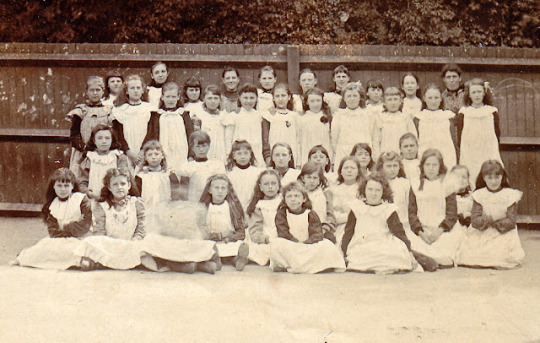
An example of the aprons worn by younger students.
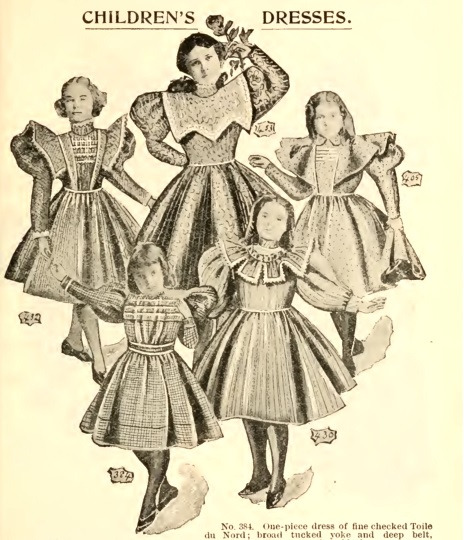
Details of the dresses worn underneath (technically from 1897 but the styles are fairly similar)
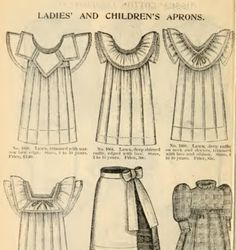
Details of the aprons worn
Older Students (Roughly years 5-7)
Around the time that the MC joins at Hogwarts, she would, depending on her personal preferences, have kept her skirt at her mid shin or dropped the hem to her ankles. Around the age of 17, girls would be expected to fully let down their hems to the floor, signifying their shift to adulthood.
At this point dresses would become less popular during the day, and were replaced by blouses (complete with very large sleeves) and a skirt. Men's tailoring and sports clothes shaped women's fashion at the time, and greatly influenced what girls wore at this age.
Girls would also typically stop wearing their hair down during the day, resorting to simple up-dos instead.
The time at which each girl made these changes depended on her and her family. While some girls had no choice but to listen to their parents, often they were able to bargain for an extra few months if they so wished.
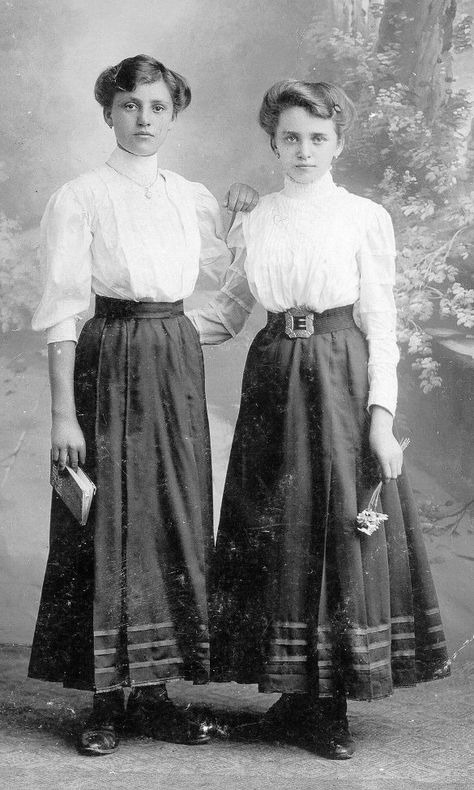
An example of two girls around the age of 15 in very typical day outfits.
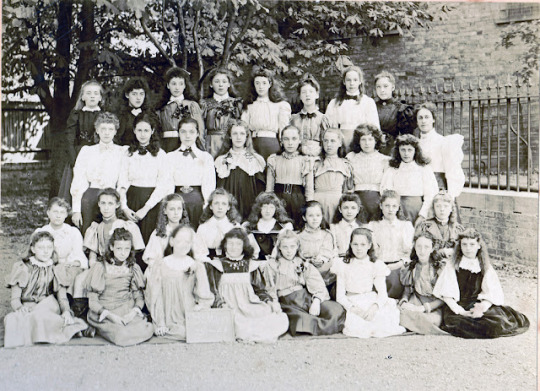
A selection of school girls - those sitting are no older than 14, those standing are no older than 16.
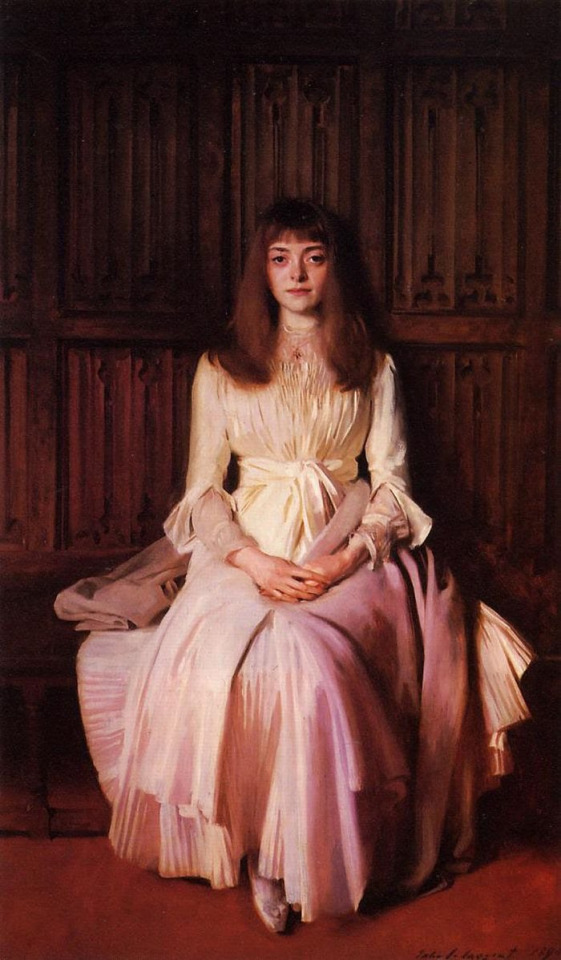

At the age of 15-16 girls would begin to attend more family functions and required new styles of clothes. These paintings show the same tea gown. These were made to be worn at home, never in public, when the family was hosted guests or a less formal dinner. They could be worn at all times of the day.
Day clothes for students who dressed as adults (17+):

A British Upper VI class (age 17-18) and some teachers in 1894. All girls now wear dresses with their hems on the ground, and hair tied up.
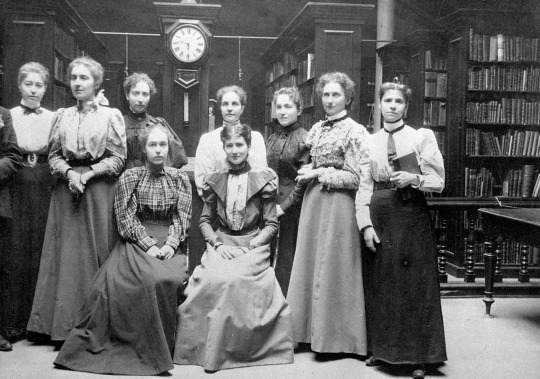
Middle class girls fashion in the 1890s
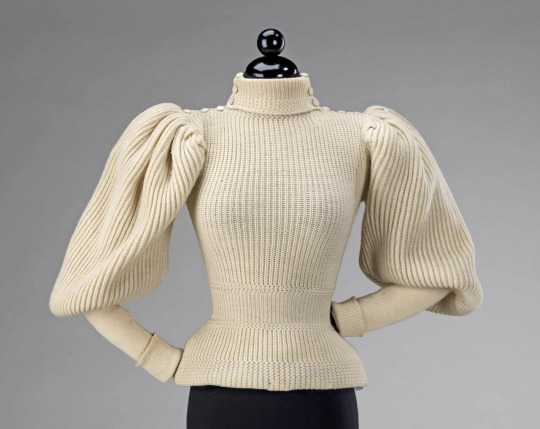
A Woman's sweater from 1895
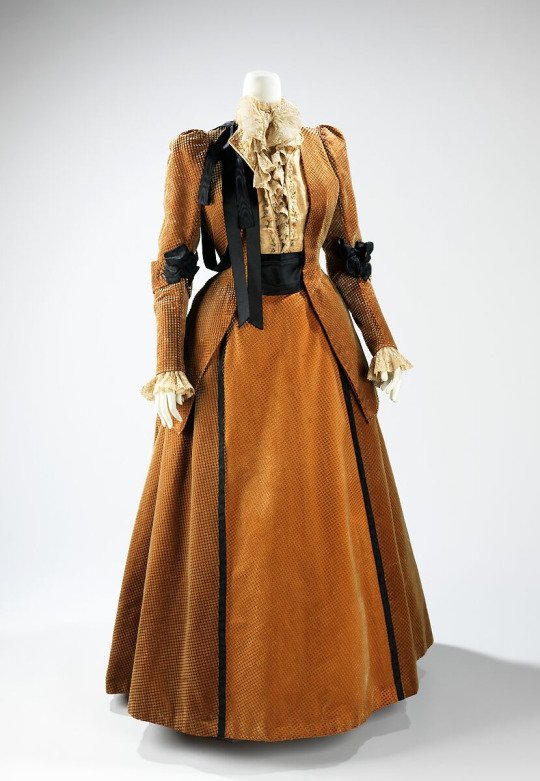
Walking outfit from 1894 - essentially a more substantial outfit for spending time outdoors.

A more expensive version of a day outfit.
Tea gowns:
Generally identified by their loose fit, high neckline, and a train that falls from the shoulders. Additionally they may also be made with a large coat over the top. The shape was inspired by medieval fashion and so they're a good source of inspiration for the wizarding world imo.

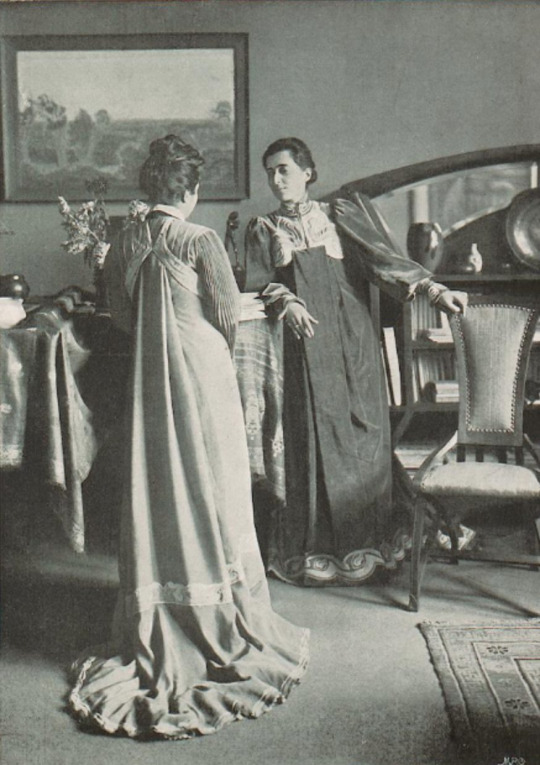


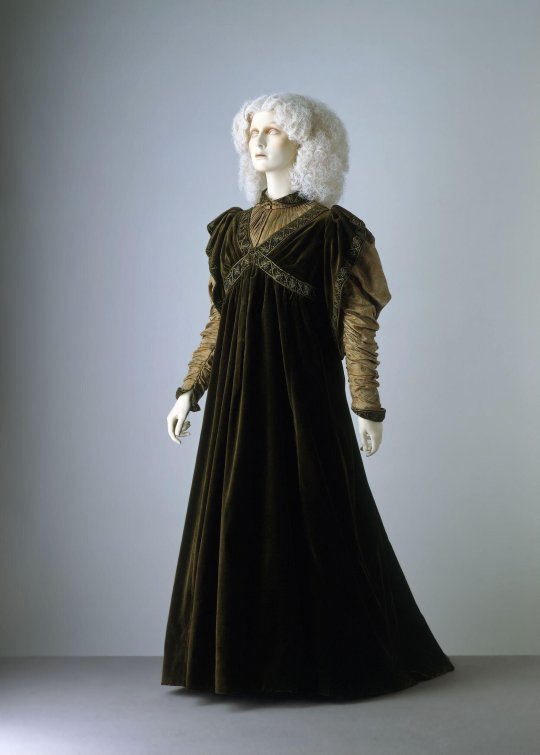
Evening gowns:
Worn for the most formal evening events, and generally expose more skin than day clothes. Staple accessories included fans, opera gloves, and (if you're that way inclined) tiaras were coming into popularity at this time.
Rule of thumb for all fashion at this time, the sleeves get largest in the middle of the decade, and shrink back down again towards the end.

1894

1893

1898

1893-1895

1894

1898
#Wow first post on this account is the nerdiest thing i could possibly pick#enjoy!#hogwarts legacy#harry potter hogwarts game#sebastian sallow#sebastian sallow x mc#sebastian sallow x you#sebastian sallow x reader#ominis gaunt#ominis gaunt x you#ominis gaunt x reader#garreth weasley#garreth weasley x mc#garreth weasley x reader#ominis gaunt x mc#hogwarts legacy art#hogwarts legacy mc#historical references#fashion references#1890s
2K notes
·
View notes
Text





Legitimately can't explain what caused me to get just get really into this hetaliaAU that exists solely in my brain but I couldn't stop
At first it was just imagining like a Japanese woman in kimono in like 19th century New York and then I started thinking about how amazing fem japan is and like then ameripan came in and now I'm like losing it
#amepan#ameripan#nyo japan#hws japan#hws america#hetalia#hetalia fanart#historical hetalia#my art#no one gets nyo japan like me (i hate “canon” nyo japan and will rebuild her to be a complex character)#i did start thinking about how epic nyo japan would be when learning that like super pre history japan#like women were religious and social leaders#theres also that one chinese record of the kingdom of wei#which to be clear historical accuracy of thst is unclear but it does seem to link to modern day japan#and in the record its like “the people here saw male rulers were causing problems so now only women rule” and theres princess himiko#ANYWAY i could talk about my decisions on why i think japan depicted as a woman is best but i wont here#also its embarrassing posting hetalia on my main#it ferls like i need a secret account#suggestive cw
340 notes
·
View notes
Text


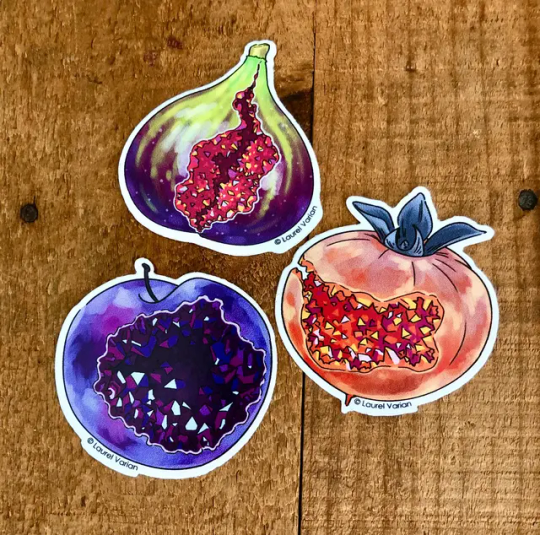




With farm work winding down for the season, I finally had time to update my shop: mini and full-sized felted mushrooms, greeting cards, stickers, and pendants!
>>Shop Link Here!!<<
#i know this historically has not been an account where i post art#but i'm too tired to rejuvenate my art account so it is what it is#signal boosts appreciated#needle felting#art#artists on tumblr#etsy store#my art
250 notes
·
View notes
Text
Varric: A giant hole in the sky.
Warden: A cult who thought Andraste was reincarnated as a dragon and guarded the temple containing her ashes.
Varric: Blighted lyrium that turns people to stone and makes shit float around.
Warden: A dragon made of lightning
Varric: ... That breathed lightning?
Warden: That too.
Varric: ... A Qunari invasion. Two of them.
Warden: A forest of sentient trees inhabited by a tribe of werewolves that are the product of a curse laid down by a Dalish Keeper
Varric: You're just making this up now.
#dragon age origins#varric#the warden#dragon age: inquisition#There are no actual historical accounts of the Warden's adventures because no one actually believes them
336 notes
·
View notes
Text
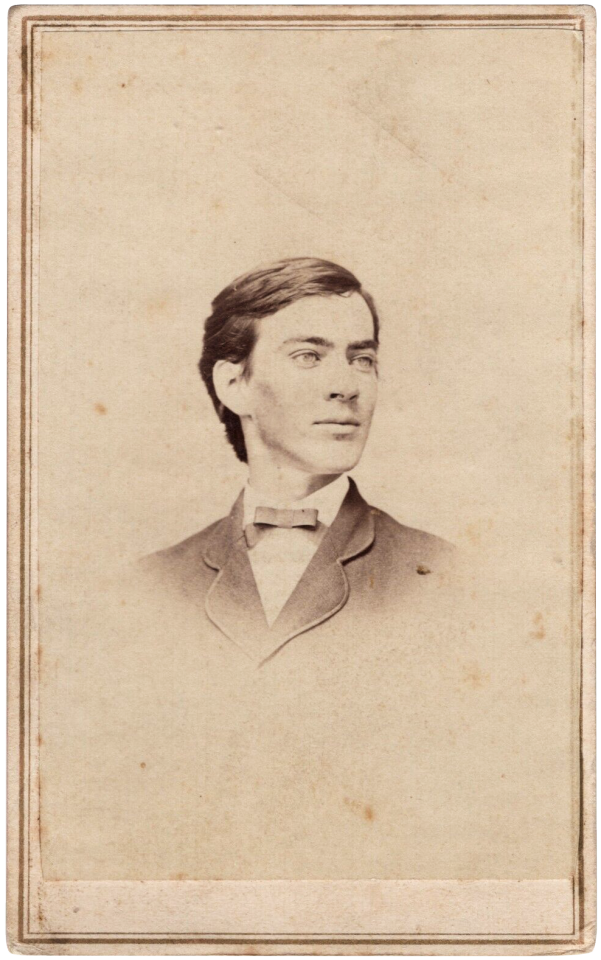
Carte de visite of a fresh-faced, confident young man with superb cheekbones, c. 1860s
#has the vibe of a man who frolics hard through dew-limned fields#but is also good at accounting#19th century#1800s#1860s#19th century fashion#men's fashion#menswear#fashion history#historical fashion#19th century photography#cdv#carte de visite#19th century men
198 notes
·
View notes
Text
Some bigender history

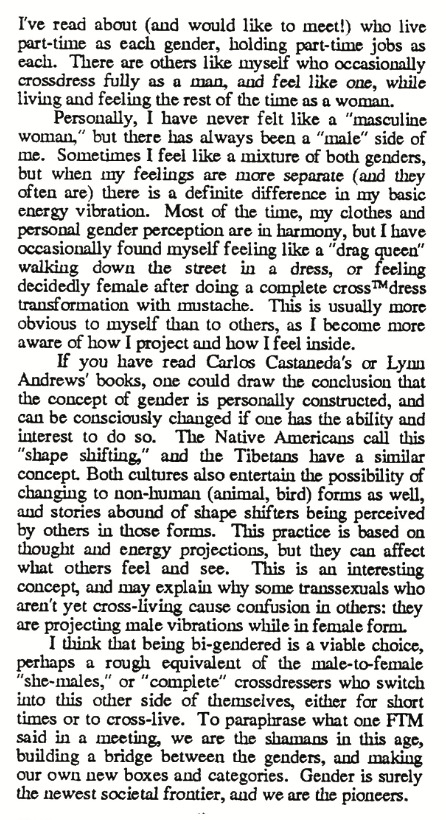
SPEAKING OF GENDER by Francis
I would like to explore the concept of being "bi-gendered" as an FTM. My own definition of bi-gendered is someone who is comfortable with feeling both "male" and ''female," either coincidentally or at separate times. This is not necessarily the same as feeling "masculine" or "feminine," since there are masculine women who identify only as women, and feminine men who identify only as men. This definition excludes sexual orientation, as a separate though related issue. As we have taught the gender workers, there are many orientations, and they may change, so there are no set combinations. I know bi-gendered FTMs who feel more comfortable living as men than as women, and take hormones, or also have upper surgery, but still acknowledge and enjoy occasionally feeling like a woman. There are a few I've read about (and would like to meet!) who live part-time as each gender, holding part-time jobs as each. There are others like myself who occasionally crossdress fully as a man and feel like one, while living and feeling the rest of the time as a woman.
Personally, I have never felt like a "masculine woman," but there has always been a "male" side of me. Sometimes I feel like a mixture of both genders, but when my feelings are more separate (and they often are) there is a definite difference in my basic energy vibration. Most of the time, my clothes and personal gender perception are in harmony, but I have occasionally found myself feeling like a "drag queen'' walking down the street in a dress, or feeling decidedly female after doing a complete cross (tm) dress transformation with mustache. This is usually more obvious to myself than to others, as I become more aware of how I project and how I feel inside.
If you have read Carlos Castaneda's or Lynn Andrews' books, one could draw the conclusion that the concept of gender is personally constructed, and can be consciously changed if one has the ability and interest to do so. The Native Americans call this "shape shifting," and the Tibetans have a similar concept. Both cultures also entertain the possibility of changing to non-human (animal, bird) forms as well, and stories abound of shape shifters being perceived by others in those forms. This practice is based on thought and energy projections, but they can affect what others feel and see. This is an interesting concept, and may explain why some transsexuals who aren't yet cross-living cause confusion in others: they are projecting male vibrations while in female form.
I think that being bi-gendered is a viable choice, perhaps a rough equivalent of the male-to-female "she-males," or "complete" crossdressers who switch into this other side of themselves, either for short times or to cross-live. To paraphrase what one FTM said in a meeting, we are the shamans in this age, building a bridge between the genders, and making our own new boxes and categories. Gender is surely the newest societal frontier, and we are the pioneers.
// FTM Newsletter #17 (1991) from Digital Transgender Archive
#bigender#queer history#trans history#multigender#lgbt history#lgbtq history#ftm#digital transgender archive#this is pretty cool! I'm happy that there's not only historical acknowledgement of bigender people#but also direct accounts from bigender people#m&f
1K notes
·
View notes
Text
thinking about the museum guests who get surprised by our photo of an Irish-Canadian immigrant maid on her wedding day, because she’s dressed indistinguishably from a wealthy woman of the same era (to modern eyes, at least)
and the thirtysomething Black femme sapphic couple I talked to at another museum who had never seen extant images of Black women in fashionable Victorian clothing until that week, and were absolutely delighted by them
thinking about how empowering it can be for historically oppressed people to learn that, no, beauty and elegance and artistic expression within this specific cultural framework were not the exclusive purview of wealthy whites until like 1920
(thinking about who it serves to erase those images and that knowledge from the public consciousness)
#dress history#history#art history#historical fashion#my favorite example is the hoop skirt#because guys those were UBIQUITOUS#cheap to make and cheap to buy#Queen Victoria wore them. Irish immigrant servants wore them. factory workers had to be expressly banned from wearing them#for safety reasons but still- that indicates that they WERE following the fashion#there are even accounts of enslaved women wearing them to church and such#and yet nowadays most Americans associate them exclusively with white Southern Belles(TM)#I've even been asked at events (while wearing 1860s) if northern women in general really wore hoops too
2K notes
·
View notes
Text
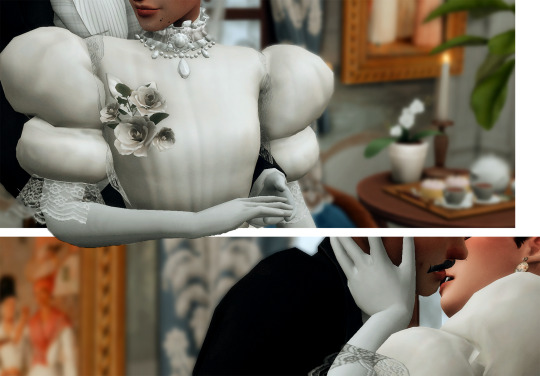


previous ➸ next | beginning
Dianora Francesca and Gianluca Andreotto Curcuruto were lustrous, opportunist and above all things, powerful. The idealistic darlings wed their courtship in the January of 1889 as they set their sights on the Americas. Amongst the Italian high society many believed the couple consummated far before their marriage, but alas rumours could only sustain themselves for so long.
Dianora was infamously charismatic; she carried herself with prowess and pride amongst her fellow socialites. She found herself often the life-of-the-party, and alongside her charm, she was rich. The daughter of a Florentine governor, the woman was priceless in the marriage market. Gianluca on the other hand was quietly awkward. He came from a family of architects and engineers, and needn’t a reason to go beyond the confinements of his office, although, alike most men of his status, he was drawn to Dianora. However, unlike those men, Gianluca’s subtle demeanour was able to capture her eye.
Upon their engagement, the couple began their journey to the New World as the social scene of New York City was yet to be conquered by Dianora and Gianluca’s prospects in engineering grew as the dream of flight became a furthering plausible possibility for human development amongst such academics of the States. The Curcuruto’s were beyond ambitious and intended to craft a legacy that would long outlive them.
#woahhh if it ain’t my first legacy post?!??!?#now i have infact done the decades challenge before on an old tumblr account that some may know as sillycaterpillars#but alas she’s been lost to internet obscurity#so here we are#may you all enjoy#the sims 4#ts4 decades challenge#!!!!!#ts4#ts4 legacy#1890s#dianora curcuruto#gianluca curcuruto#ts4 historical#simblr#ts4 decades legacy#ts4 1890s
366 notes
·
View notes
Note
For TST
I just finished listening to Elliot Page's book and I have to say it was an interesting piece of literature. I highly highly recommend it.
I have never read a book that is so closely aligned with myself as a trans man and my upbringing. I never thought I would read book that defines what it means to be a trans man in the public eye. I do not want to be as famous as him but I would like to make a change to the world as he has.
I am comfortable in who I am and who I love and how I choose to express my gender. Things really can and often do get better with time. And I hope that any person that sees this knows that they are not trapped in the shoes that society has put them in and they can actively choose a different pair.
I would love to read Pageboy soon; these memoirs and other art and literature are our history, part of our lifeblood as a community, and it's vital that we read each other's lives and understand that we truly are here in this world💛
It's great to read such a glowing review from you, and I'm so happy that his words lit your soul like it has
#ask#anon#transsexual thursday#to any trans person reading this: please document your life however you can. make music or keep a journal or paint or write books#your existence is so important and leaving as much evidence of your life as possible is important no matter WHO you are#it doesn't matter if you're famous or rich or the top in society. it matters that you *exist*#if you can and want to: documenting your life is an amazing way to engage with community and who you are#you can document anything you want or need to - the good the bad the ugly - whatever you want to share is important#i know i for one am FOREVER grateful to see historical accounts of trans people - sometimes it's all you have when you first come out#the only figures i had that i knew to look up to were men like billy tipton and dr. allan L. hart and a couple others#and while it felt lonely at first i was so comforted to know that my existence as trans and as a man was not unprecedented or unknown#so if you can/want to document yourself please do#it isn't conceited or selfish or bad. it's human. it's natural. it's revolutionary - especially when you're trans#ESPECIALLY when our history is both impressive and sometimes limited
40 notes
·
View notes
Text
respect the sentiment of the jaime loras criston cole discussion that’s like what does it say about our culture that the ability and willingness to commit violence on command can make you historically significant but big fan of every subsequent account of the dance of the dragons making it very clear that criston cole mainly came to historical significance because rhaenyra thought he was hot. like was he good at that tournament? yes! would rhaenyra have asked for him to be her personal guard which got him promoted to kingsguard which put him in a position to either start or accelerate the fall of the targaryen dynasty if he’d been ugly? no!
#also i think he’s a really interesting figure in terms of a historiographical tendency to decrease the agency of women#in favour of men#if you think of hotd as the true literal account of events f&b really exaggerates his role at the cost of rhaenyra and alicent’s#it’s interesting! i don’t think grrm meant to do this#anyway jaime loras discussion about the pitfalls of being hot at the right historical moment when? i feel like they have thoughts#asoiaf#hotd#house of the dragon#criston cole#a song of ice and fire
136 notes
·
View notes
Text
You know those "do not separate"/"often bought together" memes that people did for the Submas plushies? I like to think Immortal Volo found out that Ingo had a twin fully because he saw one of these memes and went, Ah fuck I separated them :(
#PLA#pokemon legends arceus#pokemon volo#pla volo#Submas#ingo pokemon#pokemon emmet#immortal Volo#Look me in the eyes and tell me immortal volo wouldnt be chill as hell and have a social media account#this good bitch runs a historical fact check twitter/tumblr and got recommended Submas things when Emmet/Ingo liked his train history post#and he just has to live with the knowledge he didnt buy them together and separated them#Hes like ah shit I guess to make it up to them Ill post a lot about trains :/#and when Ingo comes back and gets most of his memories back hes like VOLO WAS MY FAVOURITE TRAIN MUTUAL???? THIS BITCH????#The biggest betrayal was not that he was separated from his twin via time distortion rift#but that his mutual online didnt even fucking like trains :///////
82 notes
·
View notes
Text
Bessières and the 600,000+ Franc Question
For @josefavomjaaga
While going over sources and material related to Jean-Baptiste Bessières, there's one thing that keeps twigging my journalist Spidey sense, and I don't like that.
Always, without fail, it's presented as a fait accompli that Bessières blew anywhere between 600,000 to one million francs on his mistress, a Paris opera dancer named Virginie. The fact he had a mistress isn't actually unusual by itself, when compared to the affairs his peers carried on. The exceptions were probably the Davouts and the Lefebvres.
Furthermore, his wife, Marie-Jeanne, discovered the affair after his death when his personal affects were returned to her from the battlefield.
The massive debts the Marshal left behind bankrupted his family, necessitating that Marie-Jeanne into selling their estate, Chateau de Grignon, to cover some of it. Napoleon also paid down some of Bessières' debts and set up a yearly pension for Marie-Jeanne her son. According to some accounts, she struggled financially for the rest of her life.
This is what I don't like about it, and why it doesn't completely pass the sniff test.
I accept that Bessières died flat broke and in debt. In debt to whom, however? Who were his creditors?
When did he meet his mistress? Was that fortune spent over a period of years, or in a fairly short time?
Even as a Marshal of France he had to pay his officers out of his own pocket, and provide his own carriages and some supplies on campaign. If he was flat broke, how did he continue to pay his officers?
Bessières was also bad with money to begin with. He was known to be generous and charitable, to the point where he'd be giving away money to anyone whom he thought was more in need than he was with it. Allegedly, Virginie was in debt herself, and he paid down all of them out of the apparent goodness of his heart.
(This raises even more questions. Was she a gold digger, was she blackmailing him, was he totally besotted with her that he didn't realize what the hell he was doing? Was he just lonely? Did they have genuine feelings for one another? There's a lot of there there, but no real answers.)
My conclusion is, no, Bessières did not spend 600,000 to one million francs on his mistress. Her presence, however, was not helpful to his situation.
He paid down Virginie's debts, however much they were. Being terrible with money, he kept putting himself in a financial hole, and then he kept digging. The upkeep on Chateau de Grignon had to be ridiculous. He still had to pay his officers and his staff. He was probably borrowing and burning through money and racking up the debt. Like that meme goes, "This is fine" while everything's burning down around him. A bit like using a credit card to pay down a credit card, as one might do in the modern parlance.
(His financial problems may have contributed to his increasing depression towards the end of his life as well. Was someone blackmailing him with his debts? Another interesting question that can never be adequately addressed.)
From what I've gathered, he hid all his problems from pretty much everyone. Even Napoleon seemed caught off guard with how bad Bessières' finances were. I argue that the 600,000 to one million francs he owed upon his death were cumulative and not to a single person as the historical narrative wants people to believe.
It seems a small thing to be annoyed with, but there seems to be more than a bit of misogyny to lay all of Bessières' troubles on a single woman as the historical narrative seems to want to do.
Another thing ... if Bessières burned a lot of his recent correspondence towards the end of his life, what exactly was the evidence Marie-Jeanne discovered as proof of the affair. How did she prove it? Did other people know about the affair and kept her in the dark? If so, who was that?
In the novel, "The Battle" by Patrick Rimbaud, a semi-fictionalized account of the Battle of Aspern-Essling, Rimbaud's characterization of Bessières has him wear two gold lockets under his Marshal's uniform. One for Marie-Jeanne, the other for Virginie. I don't know if Rimbaud based that on an actual account, or if it was something he made up. I have a lot of problems with that book though, probably because the translation seems somewhat robotic and not great. It's an interesting idea, however, and maybe worth keeping around as a headcanon.
Did Madame Bessières struggle financially for the rest of her life afterwards? Possibly. I don't have enough information to make a conclusion there, but it's not impossible. She did continue to faithfully visit his tomb for years after his death.
TL;DR Bessières died broke and in debt but it wasn't all because of his mistress. If someone else has something to the contrary, I'd love to read it.
#in my headcanon#the other locket has Murat's portrait in it#now wouldn't that be trippy for people to find#jean baptiste bessières#napoleon's marshals#my old journalism professor would have an apoplexy reading some of these historical accounts#they fail the basic how what when why where test#napoleonic era
43 notes
·
View notes
Note
Is mark Antony the one who kneels or is he the one that people kneel before ?
both? like, he was Caesar’s dog, but he does not kneel before Caesar forever, and the proscriptions were a pretty clear warning light for how things would look under the new regime. Antony didn’t stop there, either: he was gunning for king of the world when he chose Cleopatra.
either way, knees or not, his teeth are sharp, look away from him at your own peril
#like even when he was Caesar’s man#he KNEW of at least one assassination plot on Caesar and kept his mouth shut on it#That man was ready to climb over a body the minute they weren’t useful for him anymore#anyway I’m not good at categorizing people into hard either-or dimensions esp bc figures like Antony contain violent#multitudes and also nothing at all (on account of the historical narrative) honestly he’s kind of a fucked up mirror#even figures I assign an archetype to it’s like. well there’s 8 or nine other things you Also Are. It’s mostly useful for storytelling#ask tag
31 notes
·
View notes
Note
POST MORE SWORD OF FATE PLS IM BEGGING
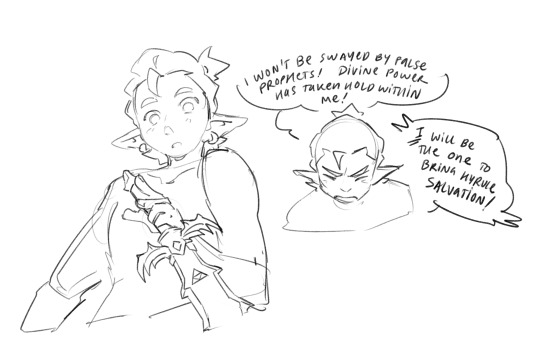
i have very little in terms of actual art LMAO but i CAN explain the sword thing because i checked and i did in fact never make this plot point public. i struggled for a while with creating a villain for this story until i realized that. i put "sword" in the title of the game. of course it has to be about the fucking sword. DUH.
so i want SOF to deal very heavily with religion, specifically the way in which hyrule's religion forms post-sksw but pre-reincarnation. i've placed it on the timeline directly after sksw, making it the first actual reincarnation in hyrule. what this means is that there's no actual proof yet that the reincarnation thing is real and not just an insane bluff on demise's part, and so several key characters including link and zelda barely believe in hylia or demise at all when the story starts. my thought with this setting's version of ganon is that he's the polar opposite of the nonbelievers. The gerudo don't really exist as of now, but he DOES come from the desert region of hyrule--specifically, he was raised in a cultlike offshoot of the sheikah religion which interpreted the hylia/demise myth completely literally and believes that a doomsday is coming, heralded by the foretold return of demise. Because of this, he knows more about the cycle and how to set it in motion than basically any other character. Crucially, he and his people are some of the only ones at this point aware of the existence of the master sword.
ganon finds. a sword. a sword which he THINKS is the master sword. and this theory is only reinforced when the sword begins to speak to him about his destiny and the salvation of hyrule. unfortunately it is not the master sword and he ends up basically a pawn in the greater plans of what's left of demise & ghirahim within that sword, manipulated into attempting to revive demise and destroy the reincarnated hero and princess. he remains in denial until basically the very end of the final battle, completely convinced that he is the true savior of hyrule and LINK is the one being misled. ghirahim is a very good manipulator lol
#i know that the sword like dies with demise in sksw or whatever but this is my game and i can do whatever i want so ive decided it survives#because i need a plot device. ok. work with me here#asks#loz: sword of fate#anyway the religion thing is something that i really wanted to explore bc it fascinates me. bc obv in later cycles everyone believes#because they KNOW its true and have like. historical evidence of it. but what about the first few times it happened? post-sksw they had no#way of knowing if demise would make good on his promise or not. i can see belief vs nonbelief being a very strong dividing factor among#early hylians. its fascinating to me. lol#anyways zelda specifically fully believes that the hylia shit was made up by her great great grandparents or whatever as a power grab lmao#link is kinda like whatever. sure the goddess exists i guess ill pray to her sometimes but like did she actually found hyrule? probably not#and ganon and his people are HARDCORE believers. like to-the-letter. because of this they have one of the most historically accurate#accounts of hyrule's founding (which no one BELIEVES is accurate at this point. but it is) and have managed to hold onto records of both#the master sword and demise when society at large has basically either forgotten or decided to ignore them#wow. i forgot how fun sof is to write about. holy shit
196 notes
·
View notes